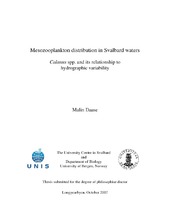Mesozooplankton distribution in Svalbard waters. Calanus spp. and its relationship to hydrographic variability
Doctoral thesis
Permanent lenke
https://hdl.handle.net/1956/3152Utgivelsesdato
2008-02-06Metadata
Vis full innførselSamlinger
Sammendrag
This thesis investigates mesozooplankton abundance, composition and distribution in Svalbard waters in relation to hydrography. Sampling was carried out in the archipelago of Svalbard mainly during summer and autumn between 2000 and 2004. From cluster analysis four species assemblages were distinguished and these reflected differences in hydrography and bottom depth. In particular the distribution of the Atlantic Calanus finmarchicus relative to that of the Arctic Calanus glacialis was associated with different hydrographic regimes. Differences in the species assemblages primarily resulted from variations in species densities rather than from taxonomical variation. For species of Atlantic and Arctic origin significant relationships with temperature and salinity were found. Regression models were used to quantify the influence of water mass characteristics on the abundance of the three different Calanus species that co-occur in the study area. About 50% of the variability in abundance of each Calanus species could be accounted for by variability in temperature and salinity. C. finmarchicus abundance was positively related to warmer and more saline waters, as expected from its distributional southern core area. Conversely, the Arctic species C. hyperboreus was more abundant in colder and fresher waters. The numbers of C. glacialis decreased with increasing temperature and salinity in shallow areas, while the opposite trend was found in deep locations. Salinity and temperature between 50 - 150 m depth were in most cases better predictors for Calanus spp. abundance than near-surface conditions. Variability in the vertical distribution of the three Calanus species and Metridia longa reflected life history and behavioural adaptations on diel and seasonal scale. Diel vertical migration was observed for copepodite stages of M. longa but generally not for Calanus spp. The copepodite stage composition indicated a south to north delay in the succession of Calanus development and that the descent to overwintering depth had started at time of sampling. The vertical distribution patterns of C. finmarchicus and M. longa were found to be consistent with the hypothesis that the developmental stages distributed according to preferences for light intensity. This thesis includes one of few year-round studies on Calanus population dynamics from the high Arctic. The three Calanus species co-existed in the studied fjord. The estimated length of the life cycle of C. glacialis (1-2 years) and C. finmarchicus (1 year) were in agreement with previous studies in Svalbard and the Arctic in general. For C. hyperboreus a one year life cycle was observed which is among the shortest life cycle duration reported for this species. Differences in winter mortality rates for the three Calanus populations indicate that these affect the species composition in the study area. The observed statistical relationships between Calanus abundance and hydrography indicate that changes in ocean climate as a consequence of global warming may alter the relative composition of the three Calanus species in Svalbard waters. However, lack of such relationship between Calanus biomass and hydrography suggests that a changing climate may induce a shift in size structure rather than in biomass which may have repercussions on the pelagic food web.
Består av
Paper I: Polar Biology 30(8), Daase, M.; Eiane, K.; Mesozooplankon distribution in northern Svalbard waters in relation to hydrography, pp. 969-981. Copyright 2007 Springer-Verlag. Full text not available in BORA due to publisher restrictions. The published version is available at: http://dx.doi.org/10.1007/s00300-007-0255-5Paper II: Journal of Plankton Research 29(10), Daase, M.; Vik, J. O.; Bagøien, E.; Stenseth, N. C.; Eiane, K.; The influence of advection on Calanus near Svalbard: statistical relations between salinity, temperature and copepod abundance, pp. 903-911. Copyright 2007 The Author. Published by Oxford University Press. Full text not available in BORA due to publisher restrictions. The published version is available at: http://dx.doi.org/10.1093/plankt/fbm068
Paper III: Marine Biology Research 4(3), Daase, M.; Eiane, K.; Aksnes, D. L.; Vogedes, D., Vertical distribution of Calanus spp. and Metridia longa at four Arctic locations, pp. 193-207. Copyright 2008 Taylor & Francis. Full text not available in BORA. The published version is available at: http://dx.doi.org/10.1080/17451000801907948
Paper IV: Polar Biology 28(7), Arnkværn, G.; Daase, M.; Eiane, K., Dynamics of coexisting Calanus finmarchicus, Calanus glacialis and Calanus hyperboreus populations in a high-Arctic fjord, pp. 528-538. Copyright 2005 Springer-Verlag. Full text not available in BORA due to publisher restrictions. The published version is available at: http://dx.doi.org/10.1007/s00300-005-0715-8
